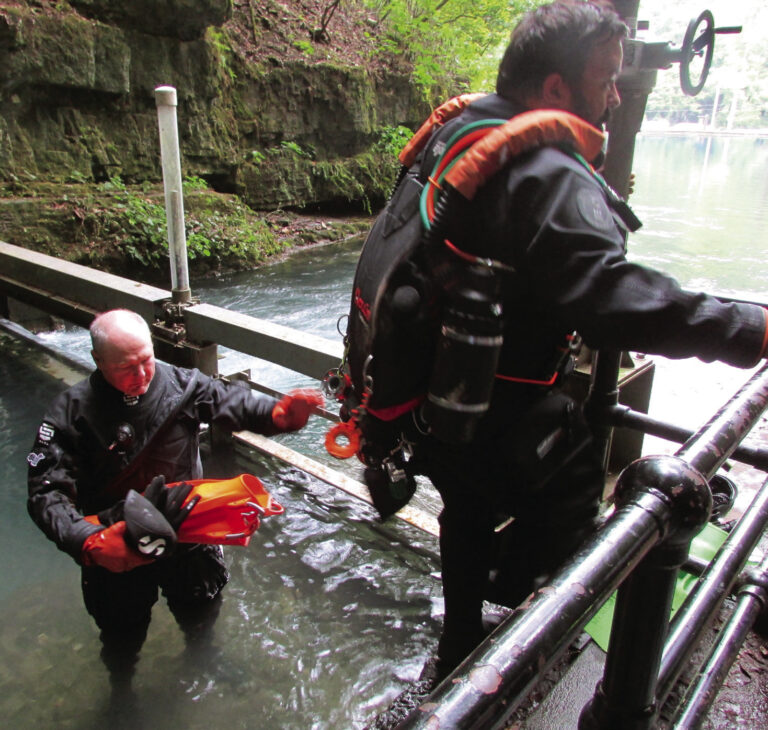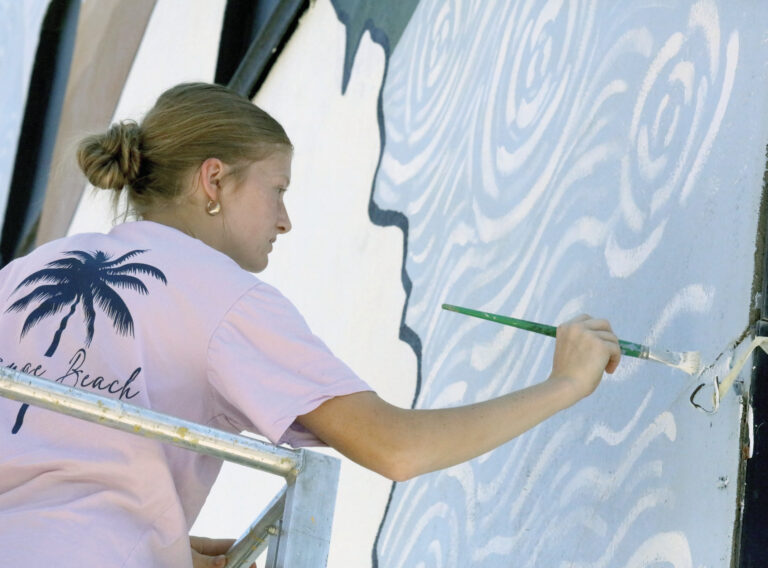12 divers part spring water

Special to the Cassville Democrat
A large group of divers affiliated with KISS Rebreathers were on hand Aug. 19 for the team’s first dive of the month into Roaring River Spring.
Exploration and survey of the cave continued, although no effort was made to push beyond their last 472-foot national depth-record set in November of 2021.
New devices and new faces were present at the spring in August.
Woody Alpern and Gus Gonzalez, the hosts of Youtube Channel’s Dive Talk – friends of KISS Rebreathers CEO and head diver, Mike Young – made their first visit to Roaring River State Park. Both Gonzalez and Alpern hail from the Atlanta area, where they dive regularly for the Georgia Aquarium. Alpern, a 46-year veteran of diving, grew up catching lobsters off the coast of Florida.
He said navigating the unexplored area of Roaring River Cave filled him with a sense of awe.
“I laid survey line in virgin territory today,” he said. “We saw stuff down there nobody’s ever seen before, and, after we leave, it will probably never be seen again. That’s pretty amazing to think about.”
Alpern finds the scale of underwater depth compared to the same linear measurement on dry land fascinating to ponder.
“When you look at 250 [horizontal] feet on land,” he said, as he gestured toward the hatchery in front of him, “it doesn’t seem very far, but when you’re underwater and under pressure, 250 feet means something entirely different. When it takes all of this gear to dive only 250 feet, you become aware that you’re really barely able to go anywhere. You get an even better sense of that scale when you’re diving into the ocean.”
Alpern says the Dive Talk episode featuring the KISS Rebreathers team’s dive into Roaring River Cave will be available for viewing on Youtube in about three weeks.
In addition to the Dive Talk hosts, marine biologist Dr. Fernando Calderón Gutiérrez was again present for the August dive with hopes of collecting more subsurface critters.
During the Aug. 19 dive, KISS diver and cartographer Jon Lillestolen nabbed an amphipod measuring about a half-inch (one centimeter) in length.
“It’s the largest one we’ve caught yet,” he said.
Gutierrez said he hopes three or four more of the same variety can be captured.
“It takes about five organisms of any given species to ensure that both genders are present so that we can determine the species,” he said. In addition to catching an amphipod, Lillestolen reported that he and Woody Alpern laid an additional 257 feet of horizontal survey line in the room below the restriction, or “The 100-fathom Abyss,” as Lillestolen refers to it. It is now known that that room is capable of accommodating a structure as tall as the 550-foot Washington Monument with its pinnacle protruding into the air bell above the subsurface portion.
“We are getting a better idea now of the dimensions of some of the walls of that room,” Lillestolen said. The depth of that abyss, from which the spring originates, however, remains unknown. On Aug. 21, during the team’s last dive of the weekend, Lillestolen tested an underwater electronic navigation system, marketed as a Seacraft ENC (Electronic Navigation Console). With the ENC mounted on a scooter (a motorized device that helps propel a diver through the water), Lillestolen took it below the restriction to collect data in a way that is purported to be more efficient than manual data collection.
“The ENC essentially collects the same data we would collect during a manual survey, but in a different way, and what is supposed to be an easier way,” Lillestolen said. “In a manual survey, we measure the pre-knotted diveline, directly, by counting the knots, which tell us the distance traveled. We also collect the depth and magnetic bearing (compass reading) of the line. The ENC is supposed to speed up that process so we don’t have to remain at depth as long.”
Required decompression time accumulates quickly for every minute divers spend – and every foot they descend–- below the restriction in the cave that exists at 225 feet below the surface of the water.
A few of the divers tested another new device geared toward individualizing a diver’s required decompression time. The O’Dive uses ultrasound Doppler technology to measure the gas microbubbles remaining in a diver’s veins after a dive. It then gives them a number on an index from 0 – 100 (with 100 being optimal) which represents the efficacy of a diver’s decompression.
“My first score wasn’t that great: a 52,” said Gayle Orner, the team’s only female diver. “So, I adjusted my computer settings and increased my decompression time a bit. After my next dive, I got a score of 89.”
Orner added that being able to customize decompression settings based on actual venous bubble data is an exciting advancement in diving science, and that the O’Dive should help to improve diver safety.
The water from the spring was flowing at about 18 cubic feet per second for the team’s August dive.
“If the flow remains low for our September dive, we plan to dive deep again and see if we can learn more about what’s down there,” Young said.
Scheduled dive dates are Sept. 16-18.
That visit will be marked by a “Meet the Divers” event hosted by the Cassville Democrat and the Missouri State Parks system. The public is invited to join state legislators and park officials at the Emory Melton Inn Conference Center on Sept. 17, at 4 p.m., as the divers present information about their exploration of Roaring River Cave. Video footage of the project will be shown and diving gear will be on display, including a rebreather used in Ron Howard’s newly released Thai Cave rescue movie, Thirteen Lives. The presentation will be followed by a question and answer session and a children’s activity.
Divers present for the August trip were Mike Young, Tony Bryant and Greg Ables, of Fort Smith, Ark.; Jon Lillestolen and Eric Hahn, of Blacksburg, Va.; Gayle Orner and Bob Dankert, of Madison, Wis.; Randall Purdy and Mike Henry, of Kearney, Neb.; Dr. Fernando Calderon Gutierrez, of Galveston, Texas; and Woody Alpern and Gus Gonzalez, of Atlanta, Ga. Tom Creason, of Fort Smith, Ark., offered surface support.


